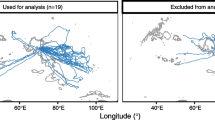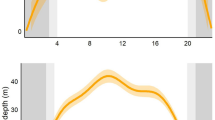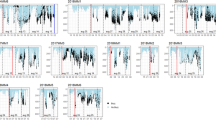Abstract
Remotely estimating prey-capture rates in wild animals is key to assess foraging success. In diving animals, accelerometers have been particularly useful to remotely detect prey captures and have been shown to be more precise than traditional estimates relying on depth-derived measures (e.g., wiggles). However, validations of the accelerometry technique using a gold standard (i.e., with supervision) have been mostly restricted to shallow diving species, which can be equipped with camera-loggers for visual validation of prey-capture events. In species diving near the euphotic limit (150–200 m), accelerometers remain mostly untested due to the difficulty of validating such methods in darkness at extreme depth in the wild. In addition, prey-pursuits in low-light conditions might not result in intense and long-duration acceleration signatures, as predator–prey perception likely occurs at close-range in the dark (i.e., the “visual-interactions hypothesis”). We combined accelerometers with beak-opening sensors (for validation) and depth recorders on a wild deep-diving seabird, the king penguin Aptenodytes patagonicus, to describe prey captures at depth and create predictive models using accelerometers. Surprisingly, prey pursuits and captures were similar in duration (3.9 ± 3.5 s) and intensity (0.78 ± 0.31 g) as shallow-diving species reported by similar studies. As accelerometry signatures were distinct, accelerometry-derived variables were almost twice as accurate (Mean-squared error = 8.6) at predicting prey-capture events as depth-derived variables (“wiggles”, Mean-squared error = 16.0). As in the shallow-diving species, accelerometry outperforms traditional depth-derived models at measuring the foraging intake in deep-diving animals, highlighting the usefulness of accelerometers for measuring animal behavior.




Similar content being viewed by others
Data availability
All data will be available on Dryad upon acceptance of the manuscript.
Code availability
Not applicable.
References
Adachi T, Takahashi A, Costa DP, Robinson PW, Hückstädt LA, Peterson SH, Naito Y (2021) Forced into an ecological corner: round-the-clock deep foraging on small prey by elephant seals. Sci Adv 7(20):3628
Bestley S, Patterson TA, Hindell MA, Gunn JS (2008) Feeding ecology of wild migratory tunas revealed by archival tag records of visceral warming. J Anim Ecol 77(6):1223–1233
Bonaccorso G (2017) Machine learning algorithms. Packt Publishing Ltd
Bost CA, Zorn T, Le Maho Y, Duhamel G (2002) Feeding of diving predators and diel vertical migration of prey: King penguins1 diet versus trawl sampling at Kerguelen Islands. Mar Ecol Prog Ser 227:51–61
Bost CA, Handrich Y, Butler PJ, Fahlman A, Halsey LG, Woakes AJ, Ropert-Coudert Y (2007) Changes in dive profiles as an indicator of feeding success in king and Adélie penguins. Deep Sea Res Part II 54(3–4):248–255
Bost CA, Goarant A, Scheffer A, Koubbi P, Duhamel G, Charrassin JB (2011) Foraging habitat and performances of King penguins Aptenodytes patagonicus, Miller, 1778 at Kerguelen islands in relation to climatic variability The Kerguelen Platea: Marine Ecosystem and Fisheries. Société Française d’Ichtyologie, pp 199–202
Brewster LR, Dale JJ, Guttridge TL, Gruber SH, Hansell AC, Elliott M, Gleiss AC (2018) Development and application of a machine learning algorithm for classification of elasmobranch behaviour from accelerometry data. Mar Biol 165(4):1–19
Brisson‐Curadeau É, Elliott KH (2019) Prey capture and selection throughout the breeding season in a deep‐diving generalist seabird, the thick‐billed murre. J Avian Biol 50(7).
Carroll G, Slip D, Jonsen I, Harcourt R (2014) Supervised accelerometry analysis can identify prey capture by penguins at sea. J Exp Biol 217(24):4295–4302
Carroll G, Harcourt R, Pitcher BJ, Slip D, Jonsen I (2018) Recent prey capture experience and dynamic habitat quality mediate short-term foraging site fidelity in a seabird. Proc Royal Soc b: Biol Sci 285(1883):20180788
Catul V, Gauns M, Karuppasamy PK (2011) A review on mesopelagic fishes belonging to family Myctophidae. Rev Fish Biol Fisheries 21(3):339–354
Charrassin JB, Kato A, Handrich Y, Sato K, Naito Y, Ancel A, Le Maho Y (2001) Feeding behaviour of free-ranging penguins determined by oesophageal temperature. Proceedings of the Royal Society of London. Series B: Biol Sci 268(1463): 151–157.
Cherel Y, Hobson KA, Guinet C, Vanpe C (2007) Stable isotopes document seasonal changes in trophic niches and winter foraging individual specialization in diving predators from the Southern Ocean. J Anim Ecol 76(4):826–836
Childress JJ, Somero GN (1990) Metabolic scaling: a new perspective based on scaling of glycolytic enzyme activities. Am Zool 30(1):161–173
Chivers LS, Hatch SA, Elliott KH (2016) Accelerometry reveals an impact of short-term tagging on seabird activity budgets. Condor Ornithol Appl 118(1):159–168
Cleveland WS, Grosse E, Shyu WM (1992) Local regression models. In: Chambers JM, Hastie TJ (eds) Chapter 8 in Statistical models in S. Wadsworth & Brooks/Cole
Crossin GT, Trathan PN, Phillips RA, Gorman KB, Dawson A, Sakamoto KQ, Williams TD (2012) Corticosterone predicts foraging behavior and parental care in macaroni penguins. Am Nat 180(1):E31–E41
Daunt F, Wanless S, Harris MP, Money L, Monaghan P (2007) Older and wiser: improvements in breeding success are linked to better foraging performance in European shags. Funct Ecol 21(3):561–567
Del Caño M, Quintana F, Yoda K, Dell’Omo G, Blanco GS, Gómez-Laich A (2021) Fine-scale body and head movements allow to determine prey capture events in the Magellanic Penguin (Spheniscus magellanicus). Mar Biol 168(6):1–15
Drazen JC, Seibel BA (2007) Depth-related trends in metabolism of benthic and benthopelagic deep-sea fishes. Limnol Oceanogr 52(5):2306–2316
Elliott KH, Davoren GK, Gaston AJ (2008) Time allocation by a deep-diving bird reflects prey type and energy gain. Anim Behav 75(4):1301–1310
Ellis K, Godbole S, Marshall S, Lanckriet G, Staudenmayer J, Kerr J (2014) Identifying active travel behaviors in challenging environments using GPS, accelerometers, and machine learning algorithms. Front Public Health 2:36
Fauchald P, Tveraa T (2003) Using first-passage time in the analysis of area-restricted search and habitat selection. Ecology 84(2):282–288
Gallon S, Bailleul F, Charrassin JB, Guinet C, Bost CA, Handrich Y, Hindell M (2013) Identifying foraging events in deep diving southern elephant seals, Mirounga leonina, using acceleration data loggers. Deep Sea Res Part II 88:14–22
Grémillet D, DellOmo G, Ryan PG, Peters G, Ropert-Coudert Y, Weeks SJ (2004) Offshore diplomacy, or how seabirds mitigate intra-specific competition: a case study based on GPS tracking of Cape gannets from neighbouring colonies. Marine Ecol Prog Series 268:265–279
Günther F, Fritsch S (2010) neuralnet: training of neural networks. The R J 2(1):30–38
Halsey LG, Bost CA, Handrich Y (2007) A thorough and quantified method for classifying seabird diving behaviour. Polar Biol 30(8):991–1004
Halsey LG, Butler PJ, Fahlman A, Bost CA, Handrich Y (2010) Changes in the foraging dive behaviour and energetics of king penguins through summer and autumn: a month by month analysis. Mar Ecol Prog Ser 401:279–289
Hanuise N, Bost CA, Huin W, Auber A, Halsey LG, Handrich Y (2010) Measuring foraging activity in a deep-diving bird: comparing wiggles, oesophageal temperatures and beak-opening angles as proxies of feeding. J Exp Biol 213(22):3874–3880
Hanuise N, Bost CA, Handrich Y (2013) Optimization of transit strategies while diving in foraging king penguins. J Zool 290(3):181–191
Hays GC, Ferreira LC, Sequeira AM, Meekan MG, Duarte CM, Bailey H, Thums M (2016) Key questions in marine megafauna movement ecology. Trends Ecol Evol 31(6):463–475
Horsburgh J, Morrice M, Lea MA, Hindell MA (2008) Determining feeding events and prey encounter rates in a southern elephant seal: a method using swim speed and stomach temperature. Mar Mamm Sci 24(1):207–217
Kirkwood R, Robertson G (1997) The foraging ecology of female emperor penguins in winter. Ecol Monogr 67(2):155–176
Kokubun N, Kim JH, Shin HC, Naito Y, Takahashi A (2011) Penguin head movement detected using small accelerometers: a proxy of prey encounter rate. J Exp Biol 214(22):3760–3767
Langrock R, King R, Matthiopoulos J, Thomas L, Fortin D, Morales JM (2012) Flexible and practical modeling of animal telemetry data: hidden Markov models and extensions. Ecology 93(11):2336–2342
Le Vaillant M, Le Bohec C, Prud’Homme O, Wienecke B, Le Maho Y, Kato A, Ropert-Coudert Y (2013) How age and sex drive the foraging behaviour in the king penguin. Mar Biol 160(5):1147–1156
Martin GR (1999) Eye structure and foraging in King Penguins Aptenodytes patagonicus. Ibis 141(3):444–450
Miller PJ, Johnson MP, Tyack PL (2004) Sperm whale behaviour indicates the use of echolocation click buzzes ‘creaks’ in prey capture. Proceedings of the Royal Society of London. Series B: Biol Sci 271(1554), 2239–2247.
Mori Y, Takahashi A, Mehlum F, Watanuki Y (2002) An application of optimal diving models to diving behaviour of Brünnich’s guillemots. Anim Behav 64(5):739–745
Naito Y, Bornemann H, Takahashi A, McIntyre T, Plötz J (2010) Fine-scale feeding behavior of Weddell seals revealed by a mandible accelerometer. Polar Sci 4(2):309–316
Naito Y, Costa DP, Adachi T, Robinson PW, Fowler M, Takahashi A (2013) Unravelling the mysteries of a mesopelagic diet: a large apex predator specializes on small prey. Funct Ecol 27(3):710–717
Naito Y, Costa DP, Adachi T, Robinson PW, Peterson SH, Mitani Y, Takahashi A (2017) Oxygen minimum zone: An important oceanographic habitat for deep-diving northern elephant seals Mirounga Angustirostris. Ecol Evolution 7(16):6259–6270
Narayanan A, Desai F, Stewart T, Duncan S, Mackay L (2020) Application of raw accelerometer data and machine-learning techniques to characterize human movement behavior: a systematic scoping review. J Phys Act Health 17(3):360–383
Orgeret F, Péron C, Enstipp MR, Delord K, Weimerskirch H, Bost CA (2019) Exploration during early life: distribution, habitat and orientation preferences in juvenile king penguins. Mov Ecol 7(1):1–17
Pichegru L, Grémillet D, Crawford RJM, Ryan PG (2010) Marine no-take zone rapidly benefits endangered penguin. Biol Let 6(4):498–501
Pucci R, Micheli A, Chessa S, Hunter J (2020) Machine learning approaches for identifying prey handling activity in otariid pinnipeds. arXiv preprint
R Core Team (2013) R: A language and environment for statistical computing.
Riaboff L, Poggi S, Madouasse A, Couvreur S, Aubin S, Bédère N, Plantier G (2020) Development of a methodological framework for a robust prediction of the main behaviours of dairy cows using a combination of machine learning algorithms on accelerometer data. Comput Electr Agri 169:105179
Ropert-Coudert Y, Kato A, Wilson RP, Cannell B (2006) Foraging strategies and prey encounter rate of free-ranging Little Penguins. Mar Biol 149(2):139–148
Ropert-Coudert Y, Sato K, Kato A, Charrassin JB, Bost CA, Maho YL, Naito Y (2000) Preliminary investigations of prey pursuit and capture by king penguins at sea.
Sato NN, Kokubun N, Yamamoto T, Watanuki Y, Kitaysky AS, Takahashi A (2015) The jellyfish buffet: jellyfish enhance seabird foraging opportunities by concentrating prey. Biol Let 11(8):20150358
Scheffer A, Trathan PN, Collins M (2010) Foraging behaviour of king penguins (Aptenodytes patagonicus) in relation to predictable mesoscale oceanographic features in the Polar Front Zone to the north of South Georgia. Prog Oceanogr 86(1–2):232–245
Scheffer A, Bost CA, Trathan PN (2012) Frontal zones, temperature gradient and depth characterize the foraging habitat of king penguins at South Georgia. Mar Ecol Prog Ser 465:281–297
Scheffer A, Trathan PN, Edmonston JG, Bost CA (2016) Combined influence of meso-scale circulation and bathymetry on the foraging behaviour of a diving predator, the king penguin (Aptenodytes patagonicus). Prog Oceanogr 141:1–16
Schreer JF, Testa JW (1996) Classification of Weddell seal diving behavior. Mar Mamm Sci 12(2):227–250
Simeone A, Wilson RP (2003) In-depth studies of Magellanic penguin (Spheniscus magellanicus) foraging: can we estimate prey consumption by perturbations in the dive profile? Mar Biol 143(4):825–831
Sutton G, Pichegru L, Botha JA, Kouzani AZ, Adams S, Bost CA, Arnould JP (2020) Multi-predator assemblages, dive type, bathymetry and sex influence foraging success and efficiency in African penguins. Peer J 8:e9380
Takahashi A, Dunn MJ, Trathan PN, Croxall JP, Wilson RP, Sato K, Naito Y (2004) Krill-feeding behaviour in a chinstrap penguin compared to fish-eating in Magellanic penguins: a pilot study. Mar Ornithol 32:47–54
Tessier E, Bost CA (2020) Behavioural adjustments during foraging in two diving seabirds: king and macaroni penguins. Mar Biol 167(9):1–11
Trathan PN, Bishop C, Maclean G, Brown P, Fleming A, Collins MA (2008) Linear tracks and restricted temperature ranges characterise penguin foraging pathways. Mar Ecol Prog Ser 370:285–294
Viviant M, Trites AW, Rosen DA, Monestiez P, Guinet C (2010) Prey capture attempts can be detected in Steller sea lions and other marine predators using accelerometers. Polar Biol 33(5):713–719
Viviant M, Monestiez P, Guinet C (2014) Can we predict foraging success in a marine predator from dive patterns only? Validation with prey capture attempt data. PLoS ONE 9(3):e88503
Volpov BL, Hoskins AJ, Battaile BC, Viviant M, Wheatley KE, Marshall G, Arnould JP (2015) Identification of prey captures in Australian fur seals (Arctocephalus pusillus doriferus) using head-mounted accelerometers: field validation with animal-borne video cameras. PLoS ONE 10(6):e0128789
Wang Y, Nickel B, Rutishauser M, Bryce CM, Williams TM, Elkaim G, Wilmers CC (2015) Movement, resting, and attack behaviors of wild pumas are revealed by tri-axial accelerometer measurements. Mov Ecol 3(1):1–12
Watanabe YY, Takahashi A (2013) Linking animal-borne video to accelerometers reveals prey capture variability. Proc Natl Acad Sci 110(6):2199–2204
Watanabe YY, Ito M, Takahashi A (2014) Testing optimal foraging theory in a penguin–krill system. Proc Royal Soc b: Biol Sci 281(1779):20132376
Watanabe YY, Baranov EA, Miyazaki N (2020) Ultrahigh foraging rates of Baikal seals make tiny endemic amphipods profitable in Lake Baikal. Proc Natl Acad Sci 117(49):31242–31248
Wilson R, Steinfurth A, Ropert-Coudert Y, Kato A, Kurita M (2002) Lip-reading in remote subjects: an attempt to quantify and separate ingestion, breathing and vocalisation in free-living animals using penguins as a model. Mar Biol 140(1):17–27
Wilson RP, White CR, Quintana F, Halsey LG, Liebsch N, Martin GR, Butler PJ (2006) Moving towards acceleration for estimates of activity-specific metabolic rate in free-living animals: the case of the cormorant. J Anim Ecol 75(5):1081–1090
Ydesen KS, Wisniewska DM, Hansen JD, Beedholm K, Johnson M, Madsen PT (2014) What a jerk: prey engulfment revealed by high-rate, super-cranial accelerometry on a harbour seal (Phoca vitulina). J Exp Biol 217(13):2239–2243
Yoshino K, Takahashi A, Adachi T, Costa DP, Robinson PW, Peterson SH, Naito Y (2020) Acceleration-triggered animal-borne videos show a dominance of fish in the diet of female northern elephant seals. J Experiment Biol 223(5):Jeb12936
Zimmer I, Wilson RP, Gilbert C, Beaulieu M, Ancel A, Plötz J (2008) Foraging movements of emperor penguins at Pointe Géologie. Antarctica Polar Biol 31(2):229–243
Zimmer I, Ropert-Coudert Y, Kato A, Ancel A, Chiaradia A (2011) Does foraging performance change with age in female little penguins (Eudyptula minor)? PLoS ONE 6(1):e16098
Acknowledgements
The study was supported financially and logistically by the Institut Polaire Français Paul Emile Victor (program no. 394 “Oiseaux Plongeurs”, P.I.C.A. Bost) and the Terres Australes et Antarctiques Françaises. This work was also supported by the Centre National de Recherche Scientifique and the Centre d’Étude Biologique de Chizé. We thank Nicolas Hanuise for its help on the field and in the preparation and analysis of the data; and Jean-Paul Gendner and Nicolas Chatelain (from the Institut Pluridisciplinaire Hubert Curien, UMR 7178 CNRS-UniSTra), who have designed and built the «SMAD», the bio-logger used.
Funding
The study was supported financially and logistically by the Institut Polaire Français Paul Emile Victor (program no.394 “Oiseaux Plongeurs”, P.I.C.A. Bost), the Terres Australes et Antarctiques Françaises, NSERC Vanier Scholarship to EBC and John and Pat Warham Studentship from the British Ornithologists Union.
Author information
Authors and Affiliations
Contributions
ÉB-C (corresponding author) did the analysis and writing, YH collected the data and helped revised the manuscript, and both C-AB and KE helped with the funding and revision of the manuscript.
Corresponding author
Ethics declarations
Conflict of interest
There is no competing interest for this study.
Ethics approval
The ethics committee of the Institut polaire français Paul-Émile Victor approved all field procedures.
Additional information
Responsible Editor: T.A. Clay.
Publisher's Note
Springer Nature remains neutral with regard to jurisdictional claims in published maps and institutional affiliations.
Responsible Editor: T.A. Clay Reviewers:undisclosed experts.
Supplementary Information
Below is the link to the electronic supplementary material.
Rights and permissions
About this article
Cite this article
Brisson-Curadeau, É., Handrich, Y., Elliott, K.H. et al. Accelerometry predicts prey-capture rates in the deep-diving king penguin Aptenodytes patagonicus. Mar Biol 168, 156 (2021). https://doi.org/10.1007/s00227-021-03968-y
Received:
Accepted:
Published:
DOI: https://doi.org/10.1007/s00227-021-03968-y




